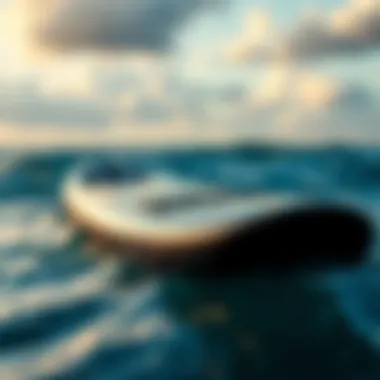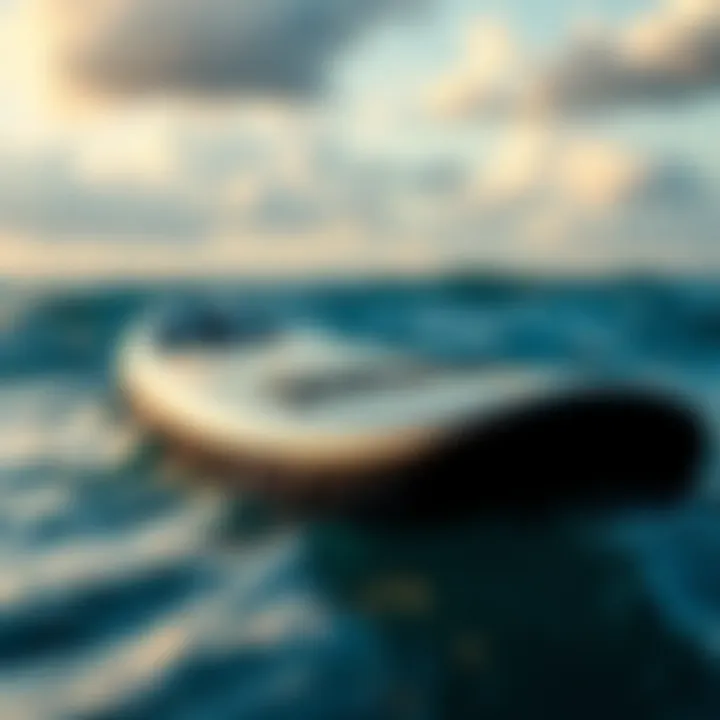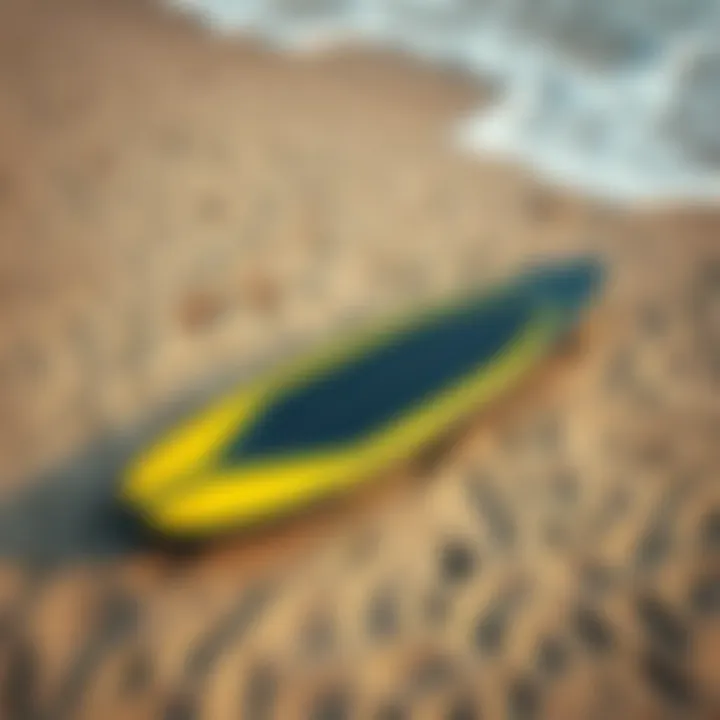Best Electric Hydrofoil Surfboards: Key Insights


Intro
Electric hydrofoil surfboards have taken the water sports world by storm, combining the thrill of surfing with advanced technology and electric propulsion. With riders gliding effortlessly above the water, these boards offer an exhilarating experience that blends adrenaline and innovation. As this niche gains popularity, understanding the various models available can seem quite overwhelming, especially for newcomers or even seasoned riders looking to upgrade their gear. This guide aims to break down the essential elements that define the best electric hydrofoil surfboards, helping you to navigate through specifications, design elements, performance metrics, and much more.
In the quest for the perfect ride, the insights into each model's features and user experiences can make all the difference. Whether you’re a surfboarding enthusiast, an outdoor adventurer, or simply curious about what’s trending in watersports, being well-informed is key. By the end of this article, you'll have a solid grasp of the innovations that set top models apart, allowing you to make a judicious choice for your next adventure.
Surfboard Technology
Innovations in Surfboard Materials
The materials used in electric hydrofoil surfboards have evolved dramatically in recent years. Gone are the days of heavy fiberglass construction. Today, most high-end boards feature carbon fiber and epoxy composite materials. These materials not only offer a substantial reduction in weight but also enhance durability. The rigidity of carbon fiber allows for improved performance and responsiveness during maneuvers in various water conditions.
Another significant advancement lies in the hydrodynamics of the board. Designers have begun integrating streamlined shapes and wing designs that minimize drag. This means that less energy is wasted, allowing riders to achieve greater speeds while still conserving battery life. The right combination of materials and design has led to boards that are not only lighter and faster but also more enjoyable to ride.
Comparing Different Surfboard Shapes
When it comes to shapes, not all electric hydrofoil surfboards are created equal. Each shape is tailored to provide different riding experiences.
- Wide Boards: These boards deliver increased stability, making them ideal for beginners. Their broad surface area helps to distribute weight evenly, which is crucial when learning to balance on the hydrofoil.
- Narrow Boards: Designed for more daring maneuvers, these boards allow for sharper turns and greater agility. Advanced riders often prefer this design for its performance capabilities, where speed and trick execution take precedence.
Ultimately, the choice of shape will depend on an individual's skill level and desired riding style. Riders should consider their own experience and the conditions they frequent before making a selection.
Surfing Techniques
Essential Skills for Beginners
For those just starting, grasping basic skills is pivotal. The first step lies in mastering balance while riding. Beginners may find it beneficial to practice on flat water before heading into choppier waves. Taking smaller strides when mounting the surfboard can also help in maintaining stability. A key aspect to focus on is weight distribution—leaning too far forward or backward can lead to an immediate downfall.
In addition, understanding how to control the throttle effectively is vital. Over-reliance on speed can lead to losing control, especially during turns. Thus, practicing gradual acceleration can help in building confidence on the board.
Advanced Maneuvers for Experts
For seasoned riders seeking to up their game, advanced maneuvers come into play. Techniques such as carving, jumps, and flips can significantly enhance the excitement of riding. However, these maneuvers require a deeper level of understanding of the foil's lift control, as well as board speed. Riders should aim to perfect their timing—the difference between pulling off a trick and crashing can be mere milliseconds. Regular practice and a keen instinct for water conditions are critical in mastering these advanced techniques.
As you ride your electric hydrofoil surfboard, remember to keep an open heart and mind to learning new skills. Riding is as much about technique as it is about starting your journey on the water.
By focusing on these foundational and advanced skills, riders can continually evolve their craft, turning every experience into a thrilling encounter with the ocean.
Intro to Electric Hydrofoil Surfboards
The concept of electric hydrofoil surfboards marks a significant evolution in the water sports arena. These surfboards, equipped with hydrofoils and electric propulsion systems, provide an exhilarating experience on the water that traditional surfing can hardly match. Many enthusiasts are drawn to the idea of gliding above water, enjoying speeds and maneuvers once only dreamed of. There’s excitement in how these boards allow riders to catch stunning views while maintaining a steady balance.
Understanding this new realm of surfing demands a closer look at the underlying technology and the advantages that come with it. From environmental issues to accessibility, these surfboards can redefine how we interact with our natural water landscapes.
Understanding Hydrofoil Technology
Hydrofoil technology is at the heart of electric surfboarding. By lifting the board above the water's surface as it gains speed, hydrofoils reduce drag and enhance stability. The mechanism is quite intriguing: a submerged wing generates lift, allowing the board to rise, creating a sensation that feels like flying. The rider can maintain a steady speed, even in turbulent waters, by managing the electric motor's power output. This might sound complex, but in practice, it simplifies maneuverability considerably.
Hydrofoils come in different shapes and sizes, each tailored for specific conditions and riding styles. The material used in the construction, often a lightweight composite, contributes significantly to performance. With such intricacies, understanding hydrofoil tech can unlock new dimensions for surfers who had their limitations bound by traditional boards. Choosing the right board often hinges on this very understanding, as each rider has unique preferences.
The Rise of Electric Surfboarding
The rise of electric surfboarding represents a paradigm shift in water sports. Affordable access to innovative technologies has made it easier for enthusiasts to dive into this fast-evolving niche. Across the globe, surf schools and rental shops are catching on, offering learners a taste of this high-tech experience – something that once felt exclusive.
With growing environmental consciousness, electric hydrofoil surfboards align with sustainable practices. Since they operate largely silently and with much lower emissions than gas-powered models, they appeal to a healthier respect for our oceans and lakes. The enthusiasm for these boards is not just rooted in the thrill they deliver but in the commitment they represent towards a sustainable future.
"Electric hydrofoiling isn't merely a trend; it's a glimpse into the future of watersports, merging adventure with sustainability."
As we progress into this guide, we will unpack critical components such as the key features that define the best electric hydrofoil surfboards, the performance metrics expected from various models, and the brands leading the charge in this exciting space. With a focus on practical insights and user experiences, this narrative aims to enrich your understanding and choices in this growing segment.
Key Features of Electric Hydrofoil Surfboards
When it comes to electric hydrofoil surfboards, understanding the key features can make or break your riding experience. These boards are not just about gliding through the water; they incorporate technology and design elements that enhance performance and usability. In this section, we’ll dive into the crucial components that define the best electric hydrofoil surfboards, and how they offer significant benefits to both beginners and seasoned riders.
Motor Power and Efficiency
The heart of an electric hydrofoil surfboard is its motor. A powerful motor not only contributes to how quickly a rider can get up and cruising, but it also plays a crucial role in efficiency.
Why power matters:
More powerful motors typically deliver better torque, which means you can accelerate quickly and maintain stability even in choppy waters. On the flip side, efficiency is equally crucial since a motor that consumes too much battery power can lead to shorter rides.
- Look for boards with motors rated between 3,000 to 8,000 watts, as they balance power and efficiency.
- Consider the type of motor: direct drive motors provide quieter operations which might be a plus for those who enjoy serenity on the water.
Battery Life and Range


Battery technology has come a long way, and it's a primary consideration when selecting the right hydrofoil surfboard. The battery's life directly correlates to how long you can ride before needing a recharge.
A typical full charge for top-performing boards lasts between 60 to 120 minutes, depending on the conditions and your riding style.
Key factors to consider:
- Capacity: Look for batteries in the range of 50Ah to 100Ah for extended rides.
- Charging time: Fast charging can mean less waiting around at the beach. Some boards can recharge in under two hours, while others might take up to six.
- Range: A range of 20 miles is becoming standard; however, some high-end models might get you up to 30 miles.
Weight and Portability
When you're hauling gear to the water, weight and portability become crucial. A lighter board not only makes transporting easier but can improve maneuverability while riding.
Considerations here include:
- Weighing between 35 to 65 pounds is common for electric hydrofoil surfboards. Models on the lighter end are preferable for younger riders or those who may find carrying heavier boards cumbersome.
- Many brands now feature foldable designs or integrated handles to assist in transport.
- Consider how bulky the board is when disassembled—some may fit snugly into a compact bag while others may require dedicated transportation solutions.
Design and Build Quality
The design and build quality of a hydrofoil surfboard go hand-in-hand with its performance. A well-constructed board is likely to stand the test of time, even through rough usage.
Features to look out for include:
- Materials used: Top-notch boards often use materials like carbon fiber or high-density foam, which ensure durability without adding extra weight.
- Fin and foil design: Adjustable foils enable riders to fine-tune their experience by changing the lift and drag, making it essential for various conditions.
- Aesthetics: While performance trumps all, a visually appealing board can enhance your riding experience. Custom designs and colors can reflect personal style, making the ride more enjoyable.
In essence, combining these features will dictate not only how well a board performs but also how enjoyable and fulfilling your hydrofoil experience will be. Choose wisely for your next ride across the waves!
Performance Metrics
When it comes to electric hydrofoil surfboards, performance metrics are pivotal. These elements not only dictate how well a board will function in various conditions but also influence the overall riding experience. Riders have varying preferences, which makes understanding the nuances of performance metrics essential. Cohesion between speed, maneuverability, stability, and control systems can turn an average ride into an exhilarating one.
Performance metrics help assess several crucial aspects. For instance, knowing how fast your surfboard can go, how well it turns, and how stable it feels on the water can significantly impact your enjoyment and safety. Moreover, they can guide potential buyers in choosing the right model that aligns with their specific needs, making the decision-making process smoother.
"The right balance of speed and stability can make the difference between a thrilling surf and a chaotic tumble into the waves."
Speed and Maneuverability
Speed is often the first number that catches the eye, and for good reason. An electric hydrofoil surfboard can deliver impressive velocities, offering riders the chance to glide effortlessly over the water. A high speed is not just about going fast; it also refers to the responsiveness of the board. A good surfboard allows quick directional changes, making those tight turns and rapid shifts possible.
Factors influencing speed include the power of the motor and the design of the hydrofoil itself. Boards with more potent motors naturally ascend to higher speeds but can also feel difficult to control if not paired with a robust design. The best boards strike a balance between acceleration and ease of turning, making it enjoyable whether you’re carving up small waves or racing across the wider expanses.
Stability and Ride Comfort
Stability contributes significantly to ride comfort, especially for those that are newer to the sport. When you’re up on that electric hydrofoil, you want to feel secure and balanced, right? A well-designed board should ensure that even at higher speeds, you don't feel like you're trying to ride a bucking bronco.
A board’s width, length, and overall construction play into this stability factor. Wider boards tend to offer a more stable ride but may sacrifice some maneuverability. Alternatively, narrower boards may be better for advanced riders who can handle a bit of wobble. Recent developments in foam-core technology have led to lighter boards that retain stability, providing an enjoyable experience no matter the rider level.
Control Systems and User Experience
Control systems have evolved dramatically in electric hydrofoil surfboards. Many models now incorporate advanced technology like wireless remotes, often with customizable settings that allow the rider to adjust speed and response on the fly. This level of control not only enhances the riding experience but also helps improve safety by allowing users to modulate their pace.
Beyond the hardware itself, the user interface must be straightforward. A complicated control system can deter newcomers. A smooth, intuitive interface contributes to a much more pleasant ride. Moreover, ongoing feedback from users is shaping these systems, ensuring they evolve to meet the needs of both casual and professional riders alike.
In essence, performance metrics are woven into the fabric of the electric hydrofoil surfboarding experience. Understanding the significant elements of speed, stability, and control empowers riders with the knowledge they need to select their ideal board and elevate their surfing adventures.
Top Brands in the Electric Hydrofoil Market
When it comes to choosing an electric hydrofoil surfboard, the brand behind the product can have a significant impact on quality and performance. Navigating the market can be a daunting task due to the myriad of options available, which is why having a solid overview of the leading brands helps consumers make informed decisions.
Brand reputation often reflects user experiences, innovations, and the level of support offered. It's important for prospective buyers to consider how each brand positions itself in the market, the types of features they offer, and the real-world feedback from users. This will assist in identifying models that not only fit your riding style but also offer the reliability and performance that enthusiasts demand.
A few notable names have carved their niche in electric hydrofoiling, each flaunting unique offerings and innovations that make their products stand out.
Brand A: Innovations and Unique Offerings
Brand A is often at the forefront, pioneering advancements that set it apart. Their electric hydrofoil models feature cutting-edge technologies, such as adaptive foils that shift dynamically based on riding conditions. This innovation greatly enhances the rider's experience, allowing for smooth transitions and increased lift. Furthermore, the brand focuses on sustainability, ensuring that their products are crafted with eco-friendly materials. This commitment not only attracts the environmentally conscious buyer but also speaks to the brand’s long-term vision for the surfboarding community.
But it’s not just technology. Comfort is key, and Brand A has designed their boards with ergonomic foot straps and an intuitive control system, making it easier for beginners to gain confidence. In a nutshell, they offer a mix of performance and comfort that many riders find hard to resist.
Brand B: Market Position and Customer Feedback
Brand B occupies a strong position in the market thanks to its durable construction and reliable performance. Users frequently laud their products for being tough enough to withstand the rigors of various waves and conditions. Feedback highlights the responsive customer service which ensures that concerns get addressed quickly, building loyalty among buyers.
Moreover, Brand B is recognized for maintaining a competitive price point without sacrificing quality. Users appreciate that they don't have to break the bank to get a solid entry into electric hydrofoiling. Whether you are just starting out or are an experienced rider, the value for money here can’t be overlooked. This brand may lack some ultra-high-tech gadgets, but their simplicity and robustness appeal to a vast audience.
Brand C: Product Range and Special Features


Brand C takes a different approach by offering an extensive range of models tailored to various skill levels and preferences. Their lineup includes boards specifically designed for speed, while others focus more on stability for those new to hydrofoiling. Riders find this versatility appealing – it’s like having a buffet of options.
Apart from the range, Brand C also invests in unique features like customizable foil sizes that allow users to tweak their setup based on riding conditions. This gives enthusiasts the ability to explore different experiences and hone their skills effectively, a feature many don't realize can significantly improve performance.
Overall, Brand C reinforces the notion that selection and adaptability can’t be taken for granted in this fast-evolving market.
Understanding the offerings of these top brands is crucial for achieving the best riding experience in electric hydrofoiling.
Whether you are a novice or a seasoned professional, these brands represent some of the best available, each with a unique spin that caters to varying tastes and requirements. The exploration of their innovations, market standing, and product ranges will guide you toward making a choice that meets your individual whims.
Cost Considerations
When diving into the world of electric hydrofoil surfboards, the impact of cost cannot be overlooked. For enthusiasts, whether a seasoned rider or a newbie looking to enter the scene, understanding pricing and value is crucial. This section will dissect the financial aspect of these watercraft, touching on how the right investment can lead to a rewarding experience on the waves.
The price range for electric hydrofoil surfboards can vary dramatically, often reflecting built quality, technology, and brand reputation. It's not just about choosing the cheapest option; consumers must evaluate what features they truly need versus what they are willing to spend. A clear grasp of cost considerations helps buyers make informed decisions that align with their surfing ambitions and budget constraints.
Pricing Breakdown: Budget vs. Premium Models
When it comes to electric hydrofoil surfboards, the distinction between budget and premium models can determine not just the immediate financial outlay, but also the long-term satisfaction.
- Budget Models: These surfboards typically range from about $4,000 to $7,000. They often attract those who want to dive into electric hydrofoiling without breaking the bank. While they can provide basic functions and an enjoyable experience, riders might find limitations in durability or features compared to their pricier counterparts. In this category, models like the Lift Foils E1 offer a decent entry point, suitable for those still finding their footing.
- Premium Models: On the other hand, premium options can soar above the $10,000 mark. These high-end boards, such as the CWC A1, are designed with advanced technology and superior materials. They often boast longer battery life, better stability, and refined control systems, worth every penny for serious riders looking for performance and longevity. Premium models often include personalized features and more robust customer support, making the initial investment feel worthwhile over time.
The challenge lies in discerning which category aligns with the individual’s surfing goals and lifestyle.
Value for Money: Assessing Features vs. Cost
A common question arises amidst the sea of options: Are you getting bang for your buck? Evaluating features against their costs is essential when selecting an electric hydrofoil surfboard.
Many potential riders might focus solely on the price tag, yet important factors include:
- Battery Life: A board that offers longer rides without frequent recharging often justifies a higher price.
- Weight and Portability: Lightweight boards enhance mobility, making transport and storage easier.
- Control and Stability: Advanced electronic systems can significantly enrich riding experience but also add to the cost.
To make a more calculated decision:
- List features that matter most to your style of riding.
- Compare prices, making sure to align with both initial costs and potential ongoing expenses like maintenance.
- Check customer reviews and testimonials, as they often speak volumes about real-world performance versus marketing claims.
"In the world of electric hydrofoiling, knowledge is as vital as a life jacket; the more informed you are, the safer your ride will be."
Ultimately, finding a balance between cost and value demands thorough research, personal preference, and, importantly, an understanding of what you desire in an electric hydrofoil surfboard. Making an educated choice will ensure that your experience on the waves is both exhilarating and fulfilling.
Maintenance and Care for Electric Hydrofoil Surfboards
Maintaining an electric hydrofoil surfboard is not just a chore but a crucial part of ensuring longer life and optimized performance. Understanding the ins and outs of upkeep helps riders avoid unexpected issues on the water. Think of it as nurturing a delicate plant: the right care makes all the difference between thriving in the waves and being stuck on the shore.
Regular maintenance keeps your board at its best, allowing you to focus on the thrill of riding rather than worrying about mechanical glitches and damages. Water sports enthusiasts must appreciate the intricate construction of these boards, as they blend advanced technology with fine materials, making maintenance essential.
Routine Checks and Upkeep
To keep an electric hydrofoil surfboard functioning like a well-oiled machine, routine checks are indispensable. Here’s how you can keep your board performing smoothly:
- Battery Health: Regularly inspect the battery for any signs of damage or swelling. Make sure terminals are clean and free of corrosion. A healthy battery is crucial; it dictates how far and fast you can ride.
- Electrical Connections: Take time to ensure that cables and connections are secure. Loose connections can lead to power issues. Look for any frayed wires, too; they need fixing before they become a bigger headache.
- Foil and Board Structure: Check the hydrofoil for dents or abrasions. A scratched foil can affect your glide and stability. Pay attention to the board's surface; repair any chips or cracks to prevent water ingress.
- Propeller Maintenance: If your board’s propeller is damaged or worn down, it can affect overall performance. Inspect for debris or bends and replace if necessary.
These checks should be done regularly, ideally before each ride. It's like conducting a mini-checkup, which only takes a few moments but helps you avoid costly repairs later.
Troubleshooting Common Issues
Even with routine checks, problems can still crop up. Here’s a handy guide on common issues and how to tackle them:
- Battery Won't Charge: Sometimes, despite plugging it in, the battery won’t start charging. First, inspect the charger and connection. Often, it’s just a loose cable. If that doesn’t solve it, the issue may lie within the battery itself.
- Loss of Power While Riding: If your board suddenly loses power mid-ride, it can be alarming. This might be due to an overheating battery or a faulty connection. Return to the dock and let your board cool down; ride only after everything is checked and tested.
- Water Ingress: If you notice water inside the board, it could be a cracked seal or joint. Dry it out as soon as possible and fix any damage. Ignoring this can lead to severe damage.
- Steering Problems: If steering feels off, check the connections to your control system. Sometimes, recalibration may be necessary. Refer to the manual for guidance on this.
Remember, while minor issues may seem trivial, tackling them promptly saves you substantial time and hassle in the long run.
"An ounce of prevention is worth a pound of cure." – Not just a saying, but a key principle in maintaining electric hydrofoil surfboards.
Staying proactive in maintenance and being able to troubleshoot common issues will enhance your enjoyment and extend the life of your electric hydrofoil surfboard. Whether you're an adventurous newbie or a seasoned rider, taking care of your gear plays a vital role in the surf experience.
User Experiences and Testimonials
Understanding user experiences and testimonials in the context of electric hydrofoil surfboards provides a treasure trove of insights that can guide potential buyers. These narratives furnish a more personal lens through which the technology and performance of these surfboards can be viewed. Often, the technical specifications might mislead if they stand alone, lacking real-world context. Thus, collecting these stories contributes to a well-rounded evaluation of what it’s like to ride one of these innovative boards and how they hold up over time.
User testimonials shed light on not just the praises but also the pitfalls associated with particular models. This helps future buyers navigate through the noise when making purchase decisions. When novices and seasoned surfers share their thoughts, it shapes expectations, raises awareness around maintenance needs, and highlights experiences that might not be captured in mere specifications. Engaging with these real-life accounts can be enlightening, revealing how electric hydrofoils perform in various conditions and skill levels.
Beginner Stories: First Impressions
For beginners diving into the world of electric hydrofoil surfing, the experience can be both thrilling and daunting. One common theme across numerous testimonials is the initial struggle to balance and maneuver the board. Take Lucy, a first-time rider from Florida, who recalls her first experience with a surfboard designed by Lift Foils. "At first, I felt like a fish out of water. My knees were shaking, and I toppled over a few times. But once I got the hang of it, it was pure magic—flying above the waves gave me a rush unlike anything else!"


Such beginner accounts underscore the steep learning curve associated with electric surfboards. Yet they also highlight significant breakthroughs that come from persistence. Most novices shared stories of gradual improvement, transitioning from awkward starts to extended rides without wiping out. Overall, these narratives resonate with many who might feel intimidated, illustrating that patience and practice blend into the joy of riding.
Key takeaway lessons from beginners also pivot around the importance of getting familiar with the board’s controls. Learning to master the throttle and the weight distribution on the board can drastically impact the overall experience.
Experienced Riders: Advanced Insights
When it comes to experienced riders, the perspectives shift to the performance nuances and advanced techniques that can enhance one's riding experience. Testimonies from hardcore enthusiasts often reveal distinctive features and functionalities they appreciate in their boards. For instance, Marco, a seasoned rider, swears by the agility of his eFoil by eFoil. "The responsiveness is what sets it apart! You can carve turns with impressive precision, and the battery life is commendable, lasting for hours of adventure without a hitch."
Advanced riders not only seek speed and stability but also focus on aspects like battery recharging speed and hornet’s sting of agility. They often conduct comparative analyses and share their findings, making them invaluable resources for new users trying to make a purchase. Furthermore, they frequently discuss real-life performance regarding conditions like wind and wave size, lending credence to features that may not be as pronounced in a product review but matter greatly in actual use.
These seasoned surfers tend to be well-versed in troubleshooting and maintenance too, sharing insights on how to keep the equipment at optimal levels. For instance, many pointed out the necessity of rinsing the board after saltwater use to extend its lifespan—a valuable nugget of wisdom for anyone looking to invest long-term.
In summary, user experiences and testimonials provide a multi-dimensional perspective on electric hydrofoil surfboards that enriches the understanding of these unique watercraft. They reveal a world of potential surprises and joys, varied across the spectrum of surfing skill levels. For those contemplating this exhilarating journey, tapping into these experiences can illuminate the path ahead.
Comparative Analysis: Best Electric Hydrofoil Surfboards
When stepping into the waters of electric hydrofoiling, knowing how various models stack up against each other is vital. The comparative analysis sheds light on the unique features, specifications, and performances of electric hydrofoil surfboards available on the market. By digging into this facet, surfboarding enthusiasts can make informed decisions about which board best suits their needs and style of riding.
Understanding the nuances between different models can mean the difference between soaring high above the waves or struggling just to stay afloat. A well-rounded guide will not only highlight the diverse offerings but will also emphasize the advantages and limitations inherent to each choice, ensuring you don’t splash out on a model that doesn’t tick all your boxes.
Comparative Features and Specifications
In this section, we'll unravel a handful of key features that often sway purchase decisions among electric hydrofoil surfboards. These specs include the motor capacity, battery longevity, their design integrity, and construction materials.
- Motor Power: This aspect typically ranges from 3 kW to about 12 kW, impacting speed and how well the board handles challenging water conditions.
- Battery Life: Depending on the board, battery life can span anywhere from 30 minutes to several hours on a single charge, affecting how much time you can spend on the water before needing to recharge.
- Weight Capacity: Some models support higher riders' weights, crucial for performance. Being aware of how much weight a board can handle is essential when factoring in rider size or extra gear.
- Foil Design: The shape, size, and material of the board's foil can greatly influence lift and overall handling. Some riders may prefer a larger, more stable foil for ease of use, while advanced users often seek out nimble designs that allow for tighter turns and jumps.
By focusing on these comparative features, buyers can get a clear picture of what they’re investing in. Knowing these specs assists readers in aligning their personal preferences with the right technical setups.
Performance Comparison Across Models
Performance is the heart and soul of an electric hydrofoil surfboard. Different models exhibit varying traits that can elevate or diminish the riding experience. Here’s where a thoughtful performance comparison packs a punch.
- Speed: Some boards can easily reach speeds of up to 30 mph, while others sit comfortably around 18 mph. Depending on your thrill level, finding a suitable speed rating is critical.
- Maneuverability: This often relates to board length and width, alongside the design of the hydrofoil. A board that is too lengthy might be great for speed but challenging for tight corners, while a shorter board could be easier to maneuver during tricks.
- Overall Stability: Some riders may prioritize a stable ride when learning, especially considering that balance can be tricky when first starting. Features such as a wider stance or larger surface area for the hydrofoil can significantly contribute to stability.
- Control Systems: Boards packed with advanced control systems often provide a more responsive and user-friendly ride. This can include wireless remotes or smart technology that monitors speed and battery levels in real-time.
"Selecting the right electric hydrofoil surfboard equates to choosing the right set of wheels for a race; it needs to match personal driving style and performance expectations."
By diving into these varied performance metrics across models, potential buyers can assess which board may deliver the ride of their dreams, ensuring a positive relationship with the water.
Ultimately, knowing exactly what different electric hydrofoil surfboards bring to the table—and where they fall short—will guide surfers in making a smart choice tailored to their individual aspirations.
Future Trends in Electric Hydrofoiling
The world of electric hydrofoiling is on the brink of a revolutionary shift. As more adventurers take to the waters seeking thrilling experiences, manufacturers are stepping up their games to meet this growing demand. From fascinating technological advancements to environmental initiatives, the future of electric hydrofoil surfboards looks not just exciting but also responsible.
Technological Advancements on the Horizon
It’s no secret that technology evolves at a dizzying pace, and the electric hydrofoil industry is no exception. With continuous innovations hitting the market, riders can expect several significant enhancements soon.
- Smart Control Systems: Future surfboards may feature sophisticated AI-based control systems that adjust power according to rider skill and conditions. Riders can look forward to systems that learn from their riding style, optimizing performance for either leisurely, smooth rides or adrenaline-packed sessions.
- Enhanced Battery Technology: Expect batteries to become lighter and more efficient. Innovations in lithium-sulfur technology could lead to longer ride times and shorter charging periods. Imagine zipping across the waves with a single charge lasting all day!
- Lightweight Materials: Manufacturers are exploring composites and advanced plastics that are both lightweight and durable, allowing for easier transport and handling. Materials that repel water more effectively will also improve longevity and performance.
Advancements aren't just about performance; they enhance safety as well. Features like automatic shut-off systems and improved buoyancy control can make for a safer riding experience.
"The future of electric hydrofoiling is not just about speed, it’s about smart, responsible performance."
Environmental Considerations and Innovations
As the electric hydrofoil surfboard market grows, so does the emphasis on sustainability. Consumers are increasingly aware of their environmental impact, and manufacturers are taking note. Several trends are emerging:
- Sustainable Materials: Companies are innovating with eco-friendly materials, such as recycled plastics and biodegradable composites. These sustainable choices not only help reduce pollution but also attract eco-conscious consumers.
- Carbon Footprint Reduction: Many brands are beginning to measure and disclose their carbon footprints. Some are committing to net-zero goals, making strides toward renewable energy in production processes.
- Eco-Friendly Design: Designs that emphasize efficient hydrodynamics can reduce energy consumption when in use. An electric hydrofoil that glides effortlessly over the waves not only extends battery life but also looks out for the marine environment.
These advancements signify a promising commitment by the industry to embrace greener options while delivering exhilarating experiences on the water. As electric hydrofoils evolve, they will not only cater to a growing audience of enthusiasts but will also consider their responsibility to our planet.
End
In the realm of electric hydrofoil surfboarding, understanding the complexities and benefits of the best models is crucial. The coastline has transformed into a playground for enthusiasts who seek the thrill of gliding above the waves, and this guide offers a clear compass for navigating the choices available.
Summarizing the Electric Hydrofoil Landscape
Through our detailed exploration, it’s plain as day that electric hydrofoils are not just a passing trend; they represent a shift in how we interact with water sports. As we dive deeper into this innovative world, we’ve dissected a myriad of features, including performance metrics, design nuances, and power efficiency. Each part plays a pivotal role in enhancing the surfer's experience. For instance, while maneuverability is essential for tricks and agile entries, stability ensures a comfortable ride for longer sessions.
Many brands have stepped up to the plate, each with unique offerings that cater to a variety of skill levels and preferences. From beginner-friendly models to advanced options designed for seasoned riders, the landscape is as diverse as the surfers who navigate it.
"The beauty of electric hydrofoils lies not only in their speed but in the freedom they offer riders to explore what was once thought impossible on the water."
As technology surges forward, future advancements promise even greater speeds and sustainability. Innovations look at optimising battery life and eco-friendly materials, painting a promising picture for electric hydrofoiling.
Final Recommendations for Consumers
For those contemplating their first electric hydrofoil or even for seasoned riders looking to upgrade, the decision can feel as daunting as picking a favorite wave. Here are critical points to consider before making a purchase:
- Assess Your Skill Level: Begin with models that match your current ability. Beginners should steer towards brands that emphasize stability and support.
- Budget Wisely: While premium models often come loaded with high-end features, assessing value for money is essential. Don’t overlook mid-range options that might suffice your surfing needs.
- Trial Runs: Whenever possible, take the boards for a spin. Feeling the board in action can provide insights that specs simply can’t.
- Community Feedback: Reaching out on platforms like Reddit or specialized surf forums can yield firsthand insights and recommendations based on user experiences.

